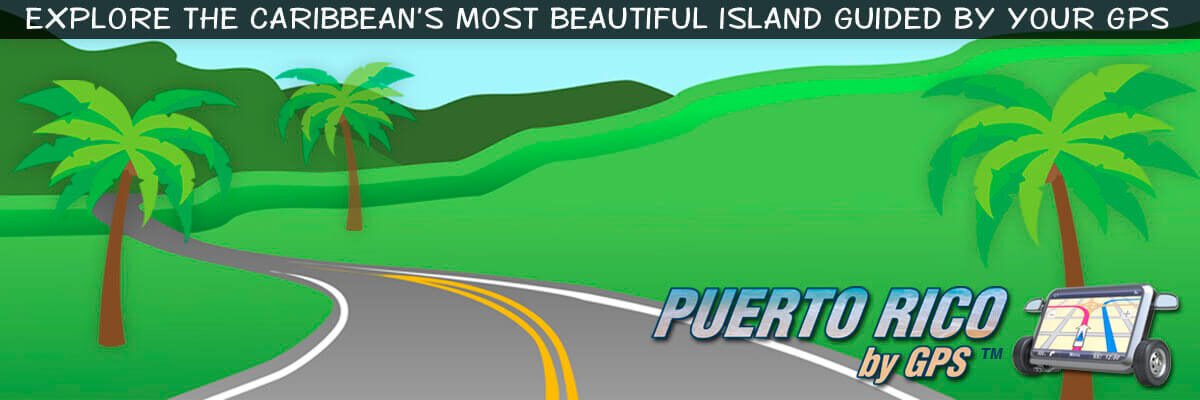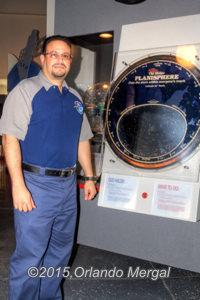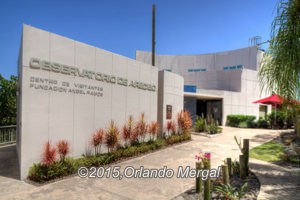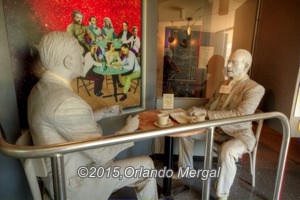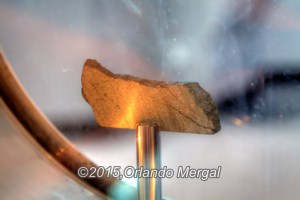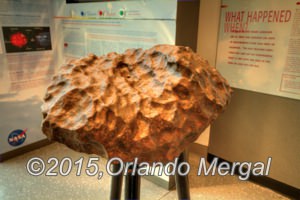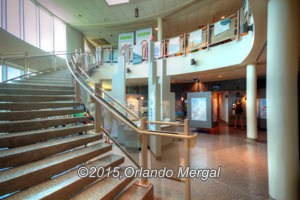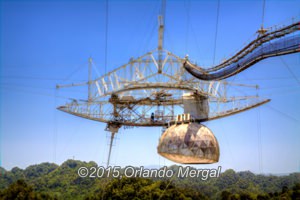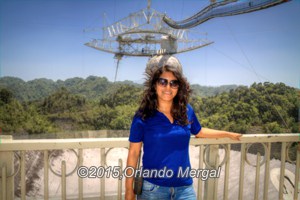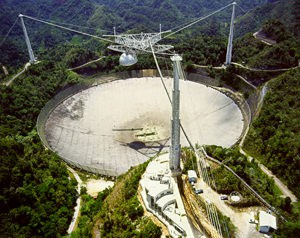
Arecibo RadioTelescopy (photo courtesy of NAIC-Arecibo Observatory, an NSF facility.) Click on image to see it larger.
NOTE: THIS DISH NO LONGER EXISTS. THE IMAGE THAT YOU SEE BELOW IS OF WHAT IT ONCE WAS.
When you visit a tropical island like Puerto Rico there are things that you expect and things that you don’t. You can expect beautiful beaches, lush vegetation, old Spanish cities, wonderful food and pleasing people. But what you probably won’t expect is a high tech facility typical of NASA’s most advanced space centers.
Well, that’s exactly what the Arecibo Radio-Telescope is. And it’s just a 90-minute drive from the San Juan Metroplex.
Last Wednesday my wife and I had the unique opportunity to visit the Arecibo Radio Telescope and meet with two great people: its director Mr. Andrew W. Ortiz and one of his excellent tour guides Miss Natalia Feliciano. And believe me, it was worth every minute of our time. The place is amazing and our hosts couldn’t have been more knowledgeable, enthusiastic and pleasing.
Getting to the radio-telescope is easy if you have any sort of GPS unit. Just copy the coordinates from the map below, punch them into your own GPS unit and you’ll arrive at the front gate in no time. That’s what I did. I wrote them into the Google Maps App on my iPhone and it took me straight there.
The final stretch of the trip is quite unique as there is no indication that youre about to reach the radio-telescope. All you’ll see for the last five miles are cows and more cows. In fact, if you didn’t know about the facility you would never guess it’s there with all the cow farms that surround it.
When we got to the front gate we still couldn’t see the giant dish. That’s because it sits comfortably in a natural formation between three mountains. After registering at the gate we were escorted to the visitor center where the first thing that we saw were two life-size figures sitting at a table enjoy a cup of coffee. The man on the right is Mr. Karl Jansky and the one on the left is Sydney Chapman, and the are considered the founding fathers of radio-astronomy and ionospheric science.
Karl Guthe Jansky was an American physicist who in 1931 discovered that celestial objects emit radio waves. This discovery led to the establishment of what we now know as radio-astronomy, and more importantly, to the construction of the many radio-telescopes around the world that we have today.
Sydney Chapman was a British mathematician and geophysicist. His work on the kinetic theory of gases, solar-terrestrial physics, and the Earth’s ozone layer has inspired a broad range of research over many decades. In fact, the Arecibo Radio-Telescope’s proper name is the “National Astronomy and Ionosphere Center” (NAIC). It was originally constructed in 1963 to study the earths ionosphere and later on went on to studying outer space.
Among the many interesting exhibits that you’ll find at the center there is a satellite view of the island of Puerto Rico, as it looked back in 1997, where you can clearly see the Arecibo Radio-Telescope. Another interesting item —and one you can easily miss— is a small meteorite from Mars— discovered in Nigeria. We know it’s from Mars because it contains trace elements that are only found in the Martian atmosphere.
A few meters away there is a slightly larger one (350 pounds) that was discovered in Namibia, Africa in 1836 ad is mainly composed of nickel and iron.
You’ll also find exhibits about infrared light, the life span of different types of stars, how audio reacts in a vacuum, star constellations around the world, radio-astronomy around the world and a scale model of the Arecibo Radio-Telescope.
Everything we have mentioned so far is located on the first floor of the exhibition area and is part of the permanent exhibit. On the second floor there’s an itinerating exhibit area that presently holds a Nanotechnology exhibition. Prior to that there was a NASA exhibition complete with a real astronaut suit and different equipment used in space exploration. Exhibits on the second floor usually change on a yearly basis but if they are very popular —like the one from NASA was— they can remain for longer periods of time.
The Arecibo Radio-Telescope has come a long way when it comes to catering to tourists. Prior to 1997 the facility was mainly a research center where visitors could see the radio telescope and very little else. In fact, I remember visiting the place many years ago and there was even a glass where you could see the scientists at work and a sign that read: “don’t feed the scientists”.
Today the Arecibo Radio-Telescope is an ultra modern facility that still fulfills its research functions while receiving thousands of visitors and educating the community.
Then there’s the dish. After exiting the visitor center we went straight to an observation deck that’s right at the edge of the 1,000 foot dish. And believe me, it was a jaw dropper. It was the brainchild of Dr. William E. Gordon, a Cornell University professor who was interested in studying the ionosphere.
Construction started in 1960 under the supervision of doctor Gordon and three years later it was completed at an estimated cost of 9 million dollars. According to the Bureu Of Labor Statistic’s inflation calculator that would be about $71,368,175.68 in today’s dollars.
So why did doctor Gordon and his team decide to build this multi-million dollar facility —the largest of its kind in the world— in the middle of nowhere? Well, there were three main reasons. The first reason was because the money came from the U.S. Department of Defense and they wanted it to be on U.S. soil. The second reason was because Puerto Rico is the U.S. territory closest to the equator and that would add to the instrument’s accuracy. And finally there’s the geomorphology of the site.
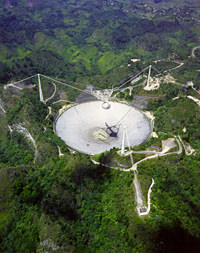
The Arecibo Radio-Telescope dish sits comfortably between three mountains. (photo courtesy of NAIC-Arecibo Observatory, an NSF facility.) Click on image to see it larger.
The Arecibo Radio-Telescope sits between three mountains that practically resemble the size and shape of the reflector dish. Therefore, it required a lot less excavation to construct and —of course— a lot less money.
The radio-telescope is comprised of three main elements: the three concrete towers which rise an average of 300 feet into the sky, the platform and the reflector dish. The towers get their names from the numbers on a typical clock. The one pointing north is tower number twelve (265 feet), the one pointing southeast is tower number four (265 feet) and the one pointing southwest is tower number eight (365 feet). Together they form a perfect triangle.
The center platform is suspended 450 feet above the dish by steel cables capable of holding up to ten tons each. These cables are the original ones installed back in 1963 and they are periodically treated with dry oxygen to avoid corrosion.
The platform is subdivided into five parts. These are: the triangular base that suspends it from the cables, the circular base that allows the instruments to rotate 180°, the azimuth that allows the instruments to move along a vertical semicircle, the Gregorian dome that holds the instruments used for out space exploration and the 430 antenna which is used for ionospheric analysis.
One thing that caught my attention was what our guide Natalia said about the Gregorian dome: “it looks small from the observation deck, but it’s actually about the size of a six story building”. ¡Wow!
The 430 antenna gets its name from the fact that it works at a frequency of 430MHz. This antenna is used to study the earth’s ionosphere, which was the reason for building the facility in the first place.
Finally, the fixed dish is 305 meters across, which boils down to 1000.7 feet. It is made up of almost 40,000 3’X 6′ perforated aluminum panels. This makes the dish a reflective surface for radio waves and a “transparent” surface for rainwater and sunlight. Hence the aquifers that lay below the dish are not affected by it and there are even plants growing below its surface.
On the very edge there’s a fence-like structure that anyone (including me) would have expected to be for keeping animals (both quadruped and biped) off the dish. Well it’s not. It actually serves a technical purpose. It keeps spurious signals from cell phones, radio stations, tv stations and any other type of radiofrequency that might hinder the performance of the instruments from reaching the dish. In other words, it acts as a giant Faraday cage. It also helps keep the useful signals in.
The radio telescope mainly conducts two types of studies: passive and active. Passive studies (radio-astronomy) are used to study light emitting celestial bodies like stars, galaxies or pulsars which, like Karl Jansky discovered, also emit radio waves. These signals hit the dish, bounce back into the Gregorian dome and go through fiber optic lines to the control room where scientists analyze them with the aid of sophisticated computers.
Active studies (radar astronomy) are used to study objects that don’t emit any light like meteors, asteroids and planets. In this case the radio-telescope sends a radio signal that hits the object reflects back into the dish and is then analyzed. The facility has its own diesel generators because the amount of power (1.2 million watts) that the radio-telescope draws when it is in the transmitting mode is so great that it would leave Arecibo in the dark every time they “flipped the switch”.
Finally, one of the most important tasks performed by the Arecibo Radio-Telescope is the study of near earth objects. In layman’s terms big chunks of rock that could hit our planet and mess things up for humanity. I spoke extensively about this subject with Andrew Ortiz and it’s not quite like they present it in the Hollywood blockbuster “Deep Impact”. However, there are actually ways to divert such objects if we can only identify them in time. We also spoke about the fact that the Arecibo Radio-Telescope was instrumental in the recent discovery of sea water on Mars! If you would like to listen to my interview with Ortiz in its entirety you can listen to episode 150 of my podcast “Hablando De Tecnología”. However, you will need to brush up on your Spanish.
The Arecibo Radio-Telescope is normally open to the public Wednesdays thru Sundays, from 9:00am to 4:00pm. However, during the months of June and July it’s open 7 days a week. Admission is only $10 for adults and $6 for children and senior citizens over the age of 65. No reservations are required for small parties. Larger groups must call in advance.
Regular visits include two interactive exhibits, trained guides that answer your every question, an audiovisual tour covering every aspect of the observatory’s operation, and a guided tour to the observation deck. All tours, exhibits and movies are available in English and Spanish.
During certain periods throughout the year the observatory undergoes a maintenance schedule which is also used to conduct VIP tours. Participants in these tours get to see the inner workings of the facility and get to visit areas such as the maintenance shops, power plants, dish footings… in other words: “the whole shabang”. These tours have a 100% surcharge so be ready to pay $20 instead of $10 for adults and $12 for children instead of $6. But hey, if you’re really into science and radio-astronomy this is the tour for you!!!
Originally the Arecibo Radio-Telescope was managed by Cornell University, but in 2011 it passed over to a consortium formed by UMET (Universidad Metropolitana de Puerto Rico) (a local university owned by the Ana G. Méndez Foundation), the Stanford Research Institute and USRA (Universities Space Research Association).
For information more please call 787–878-2612, ext 346 or visit the observatory’s website at: https://www.naic.edu/.
©2015,Orlando Mergal, MA
____________________
Bilingual Content Creator, Blogger, Podcaster,
Author, Photographer and New Media Expert
Tel. 787–750-0000, Mobile 787–306-1590
